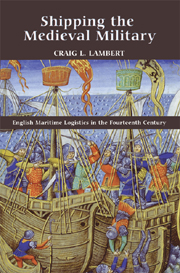Book contents
- Frontmatter
- Contents
- List of Tables
- Acknowledgments
- Abbreviations
- Introduction
- 1 Raising a Fleet
- 2 The Supply of Armies and Garrisons by Sea, 1320–1360
- 3 The Transportation of English Armies to France, 1324–1360
- 4 Maritime Resources and the King's War
- Conclusion
- Appendix 1 Ports that Supplied Ships to the Fleets
- Appendix 2 Reconstructing the Merchant Fleet: A Methodology
- Bibliography
- Index
- Warfare in History
Conclusion
Published online by Cambridge University Press: 12 September 2012
- Frontmatter
- Contents
- List of Tables
- Acknowledgments
- Abbreviations
- Introduction
- 1 Raising a Fleet
- 2 The Supply of Armies and Garrisons by Sea, 1320–1360
- 3 The Transportation of English Armies to France, 1324–1360
- 4 Maritime Resources and the King's War
- Conclusion
- Appendix 1 Ports that Supplied Ships to the Fleets
- Appendix 2 Reconstructing the Merchant Fleet: A Methodology
- Bibliography
- Index
- Warfare in History
Summary
This study has investigated the maritime involvement in the wars conducted by Edward II and Edward III between 1320 and 1360, a 40-year period that certainly witnessed England's greatest military endeavours of the middle ages. The kings of England were, for much of this time, engaged in two inter-related wars against two other kingdoms. The militarisation of sections of England's population had been gathering pace since the wars initiated by Edward I in the 1280s. This study has aimed to demonstrate that it was not only the English landed community that felt the impact of these wars, but also the maritime sections of society. Indeed, to analyse fully the effects of the wars on England's society and economy one needs to take account of all aspects of the war effort. Edward III did not assemble 14,000 men for the Crécy expedition; he actually recruited 30,000, as he also raised 16,000 mariners to serve on board the ships that transported his army. This point is pertinent to every campaign of the period and obliges us to radically revise our estimates of recruitment and demands on the population.
The book began by examining the hidden bureaucratic procedures that underpinned the raising of a fleet in the fourteenth century. It showed that behind what, on the surface, looks like a simple procedure was in fact a complex operation organised by a skilled administrative staff who were capable of organising large numbers of men and ships and deploying them, at the same point in time, into functioning fleets.
- Type
- Chapter
- Information
- Shipping the Medieval MilitaryEnglish Maritime Logistics in the Fourteenth Century, pp. 207 - 210Publisher: Boydell & BrewerPrint publication year: 2011



